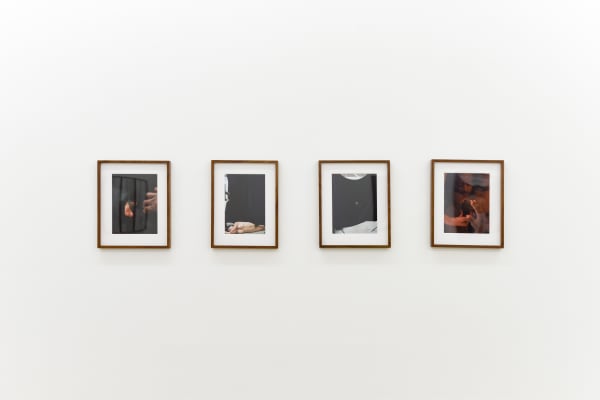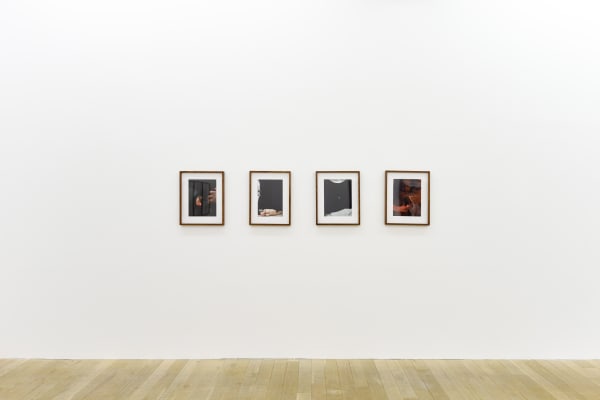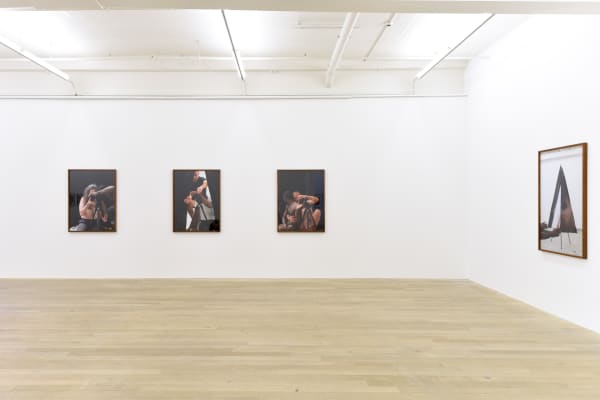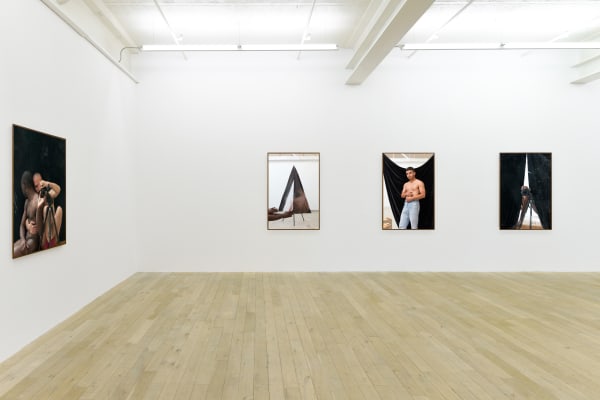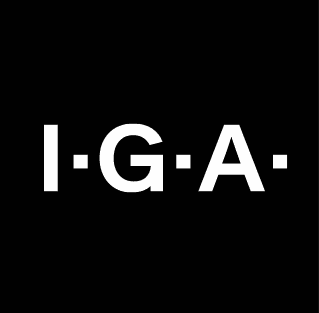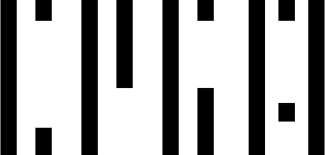Galerie Peter Kilchmann is pleased to present a solo exhibition with American artist Paul Mpagi Sepuya in collaboration with Vielmetter Los Angeles Projects. The exhibition is comprised of works made between 2017 and 2018 from a range of ongoing projects. From early photographs set in his bedroom to long-term bodies of work grounded in the photographer’s studio, Sepuya’s practice is oriented around photographic portraiture’s relationships and dynamics, its settings and materials. The camera and artist are not always visible but always implied, referring back to the self-reflexivity inherent in Sepuya’s practice and the positions and gestures of looking, being seen, and creating scenes that disregard the viewer and emphasize the making, and makers, of a picture.
The figures alongside Sepuya are friends, fellow photographers, and others from an intimate circle; those with whom a close connection forms an essential foundation and shared motivation. Out of this personal network of relationships, the handling of the camera in works like Darkroom Mirror (_1000470) highlights the poetic interplay between Sepuya and a fellow artist. Entangling the technical elements and essential conditions of portraiture, the Darkroom Mirror works negotiate shifting roles of artist and subject and play on the overlapping language of the dark room and darkroom, linking photographic sites and sites of queer socialization and sexuality.
In A Ground (0X5A7595) and Drop Scene, a Sitting for Clifford (0X5A1081), Sepuya pulls back (or cuts through) the curtain, revealing the construction of the image within the studio space, focussing our attention on the photographic tools and collapsing the distance between the image and the making- of-the-image. The photographic apparatus, positioned between the planes of the mirror and the curtain or wall reflected in the mirror, captures both reflected space and real, present space; the surface of the mirror, made evident by the bodily traces thrown into relief by blackness. The black curtain provides a material extension of the body and an abstraction of blackness - as a condition and position - that makes visible latent traces otherwise obliterated by whiteness. A traditional element of the portrait studio, the black curtain is often just a backdrop, a marginal subject; Sepuya’s works acknowledge the fundamental position of blackness as material, or blackness and darkness as a location from which and into which to look.
The material elements making up Mirror Study (0X5A7387) - the artist’s hands, fragments of test prints collaged to the mirror’s surface, the partially obscured camera-tripod figure - call into question surface, depth and the connection between the camera lens and the mirror, playing with flatness as a means of compressing and extending the spatial and temporal intervals within the studio. In this work as in several others, printed images on the floors, walls, and mirrors highlight not only how images are made, but also how they are seen and circulated outside the studio. Whether in more classical portraits such as A Portrait (0X5A1469) or the triptych Exposure (_2160212, _2160194, _2160196) (see invitation card, detail), Sepuya’s images focus inward on the motifs and conditions specific to his practice while also gesturing outward to structures and mechanics of portraiture, photography, and queer sociality. Conversing about and around pictures, Sepuya approaches photography as inseparable from the productive desire that structures queerness.
 Paul Mpagi SepuyaDarkroom Mirror (_2220717), 2018Archival pigment print116.5 x 88.5 cm (45.9 x 34.8 in.), framedEd. 2/5 (+ 2 AP)
Paul Mpagi SepuyaDarkroom Mirror (_2220717), 2018Archival pigment print116.5 x 88.5 cm (45.9 x 34.8 in.), framedEd. 2/5 (+ 2 AP) Paul Mpagi SepuyaDrop Scene (_1050992), 2018Archival pigment print114 x 86 cm (45 x 34 in.)
Paul Mpagi SepuyaDrop Scene (_1050992), 2018Archival pigment print114 x 86 cm (45 x 34 in.) Paul Mpagi SepuyaDarkroom Mirror (_2220232), 2018Archival pigment print114 x 86 cm (45 x 34 in.)
Paul Mpagi SepuyaDarkroom Mirror (_2220232), 2018Archival pigment print114 x 86 cm (45 x 34 in.) Paul Mpagi SepuyaDarkroom Mirror (_2060950), 2017Archival pigment print33 x 25.5 cm (13.0 x 10.0 in.)
Paul Mpagi SepuyaDarkroom Mirror (_2060950), 2017Archival pigment print33 x 25.5 cm (13.0 x 10.0 in.) Paul Mpagi SepuyaA Ground (0X5A7595), 2018Archival pigment print33 x 25.5 cm (13.0 x 10.0 in.)
Paul Mpagi SepuyaA Ground (0X5A7595), 2018Archival pigment print33 x 25.5 cm (13.0 x 10.0 in.) Paul Mpagi SepuyaAperture (_2150280), 2018Archival pigment print33 x 25.5 cm (13.0 x 10.0 in.)
Paul Mpagi SepuyaAperture (_2150280), 2018Archival pigment print33 x 25.5 cm (13.0 x 10.0 in.) Paul Mpagi SepuyaA Portrait (0X5A1469), 2017Archival pigment print129.5 x 86.5 cm (51.0 x 34.1 in.)
Paul Mpagi SepuyaA Portrait (0X5A1469), 2017Archival pigment print129.5 x 86.5 cm (51.0 x 34.1 in.) Paul Mpagi SepuyaDarkroom Mirror (_2210247), 2018Archival pigment print116.5 x 88.5 cm (45.9 x 34.8 in.), framedEd. 1/5 (+ 2 AP)
Paul Mpagi SepuyaDarkroom Mirror (_2210247), 2018Archival pigment print116.5 x 88.5 cm (45.9 x 34.8 in.), framedEd. 1/5 (+ 2 AP) Paul Mpagi SepuyaDarkroom Mirror Portrait (_1000470), 2018Archival pigment print114 x 86 cm (45 x 34 in.)
Paul Mpagi SepuyaDarkroom Mirror Portrait (_1000470), 2018Archival pigment print114 x 86 cm (45 x 34 in.) Paul Mpagi SepuyaDrop Scene (0X5A0936), 2018Archival pigment print129.5 x 86.5 cm (51.0 x 34.1 in.)
Paul Mpagi SepuyaDrop Scene (0X5A0936), 2018Archival pigment print129.5 x 86.5 cm (51.0 x 34.1 in.) Paul Mpagi SepuyaDrop Scene, a Sitting for Clifford (0X5A1081), 2018Archival pigment print190.5 x 127 cm (75.0 x 50.0 in.)
Paul Mpagi SepuyaDrop Scene, a Sitting for Clifford (0X5A1081), 2018Archival pigment print190.5 x 127 cm (75.0 x 50.0 in.) Paul Mpagi SepuyaMirror Study (0X5A7387), 2018Archival pigment print129.5 x 86.5 cm (51.0 x 34.1 in.)
Paul Mpagi SepuyaMirror Study (0X5A7387), 2018Archival pigment print129.5 x 86.5 cm (51.0 x 34.1 in.)












